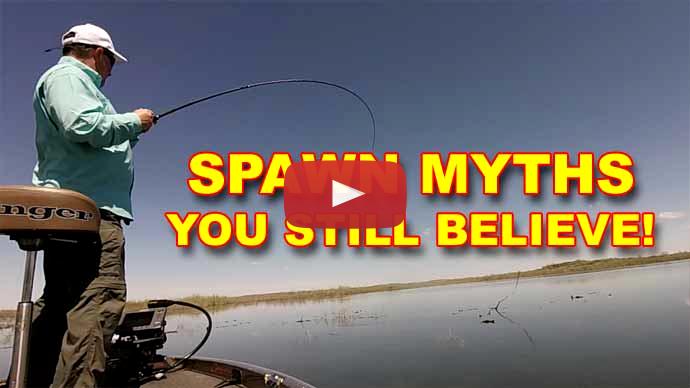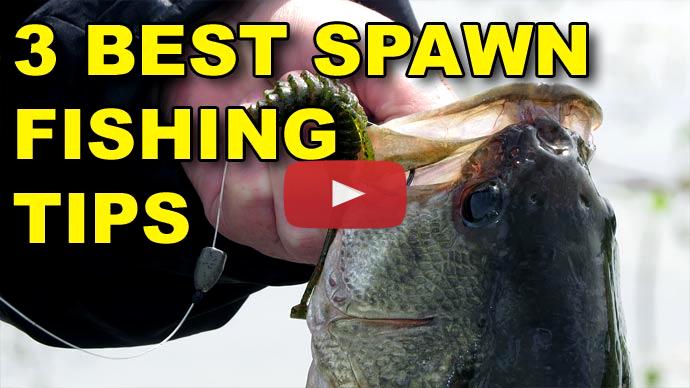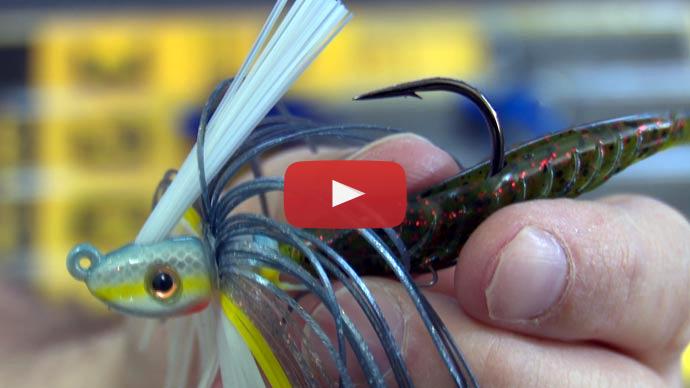Hi, I'm Bass Pro Tour angler Jeremy Lawyer, and I'm here today with Bass Resource, and I wanna talk to you about flipping around the spawn. And when you say flipping, that's not necessarily limiting you to anything. That just means that you're gonna get close and personal, and make accurate cast to whatever structure you're around on any given day on the lake that you're from. You know, that's gonna be where you're gonna make short pitches. You're gonna be looking for bedding fish. You're gonna be looking for fry guarders. You're gonna be looking for bass that are aggressive and running off the perch in the area, the nest raiders, as well as a new set of fish moving up, and something I like to do and utilize it with. And that's with a full-size jig right here in a perch color.
You know, there's nothing that imitates a big ol bream any better than just a jig. You know, this has got a lot of color in it. You can see, really imitates a nice blue gill pattern here in the Midwest. You know, this is a Structure Jig by Freedom Tackle. And if you watched us earlier videos that me and the BassResource did together, we talked about utilizing a really slow fall presentation with a 3/8 or a 5/16 ounce jig when the water was colder below 50, or just a barely above 50. Now, we're around that 60-degree range. The fish are wanting to spawn. I like to beef that up a little bit. You know, this is the half-ounce model. I feel like I can get a little bit faster fall rate. I want to tease that bass, and bring it by his nest, really quick, you know, while he is on the bed, and make him think he was gonna get anything, and kind of get him to react to the bait.
And you need just a little bit heavier jig in order to do that. You know, if the water's super, super clear, I might back this down to just regular green pumpkin, or something like a green pumpkin candy. Still gives a little bit of a hue of a bluegill off, and maybe take out the oranges in the blues. And especially if you're in the part of the country where your bluegill are more pale yellow, I might throw something, you know, like a Missouri craw pattern that has more of the pale, yellows, and greens in it, rather than a perch. But something that match your hatch in your area is what I'm kind of looking for, you know, and I'm gonna pair this on a rod. That's really what I consider not a true flipping stick for me. I prefer a longer flipping stick, but this is Denali Lithium, 7-foot-6-inch flipping stick.
And I like it whenever I'm gonna make really short flips. A lot of open water fishing, a lot of just flipping to the edge of the boat dock, or to a piece of wood that's not really big like buck bushes or willow trees, or anything like that. But the main thing is you wanna use what's comfortable for you. I'm gonna set this up with something like 20-pound Sunline FC shooter, you know, and it's gonna go ahead, and be a line that you're gonna have a snap impact really close to the boat from. And so, you want to have a line that's fairly large. You know, the fish more than likely, are not gonna be paying attention to the line anyway. So, I like to get away with the heaviest I can.
But as far as my trailers go, you know, earlier in the year when it's colder, it's warming up now. We talked about not having much movement in your trailer. I like to have quite a bit of movement now. You know, perches are real giddy. Bass are really tuned in. You know, I like to throw something that really has a lot of movement on it, you know, and just thread it on there. You know, something like a Zoom Z Craw Jr. Something with some big flapping appendages. You know, something that's really gonna imitate a perch, you know, and just thread it on there, and snug it up there tight. Now you can see here that the skirt's a little bit overpowering on that. A lot of things that happened around that spawn is official, nip at something, but not really get it all the way.
So, I really wanna fine tune this to make it a good profile, and a perch appeal bait, but not have so much to where if he just nips it this much of it thinking he's gonna do the job and run that perch off that he doesn't get the hook.
So, what I'm gonna do, is just take, and I'm gonna start trimming this thing. And the reason that I don't trim it straight across the board before I put my trailer on there, is I want the lengths of this to be just a little bit different. I'm just kind of hacking on it a little bit and shortening it up. Some of those are gonna be the same length, some of them aren't. And you can just see there. I mean, it's just gonna absolutely go round and cut that however I want. And one last thing I'm gonna do, is I'm gonna get these ones on the side, just kind of out of the way a little bit.
And what that's gonna do is cause those to really flare out. You can see there, they really wanna flare out sideways on the bait, and that's just gonna give you more action. But you can see there, I really opened that bait up, gave it a lot more action, gave a lot more appeal. But more importantly, is all the base of this bait is around the hook right here. If he just nips it at the pinchers, then that's just gonna have to be how it is. But most of the time you can get that fish to commit to a little bit more meat where that hook is by trimming that up like that, you know. Some other time, you know, you could really even put just a different trailer on it. If he's nipping at it and going crazy. Maybe you've got just a little bit too big. You know, this is a big meaty trailer. Maybe a guy needs to go to something a little more slimmer. So, if these are a little bit too fat, and a little bit too big, you know, a lot of times something just downsizing to, like, a Zoom Z Craw Jr where you still get a little bit of bulk up here in the bait at just a little bit lesser of a trailer. You know, a Speed Craw can do it as well. But there's no wrong way to do it. You know, match the hatch in your application.
Now one thing that you're gonna have to start thinking about also is that that's the time of the year when plastics are gonna start coming into play. You know, you're gonna have your good traditional Texas rig flipping style bait. I like to throw that around the spawn. Especially something like this bait here.
This is a Zoom Magnum Speed Craw. And I like it because I can put a bigger hook on it, and really get the hook exposed all the way down here at the end of the bait. Because a lot of times when they're on the bed, or they're around the bed, they're gonna just try and nip the back half of the bait. They're not really committing. But this bait here's large enough that you can put a large profile off with it, an intimidating profile off to a bass on a bed, and put a large enough Gamakatsu hook in it, that it falls all the way to the end. It's gonna be on about a big stiff Denali rod to where you don't have to worry about it. This is a 4/0 Gamakatsu Super Line that's in this. And it's just gonna be something to where your catch-up ratio is gonna be pretty good, considering the size of your bait with the size of your hook. If you throw something in there like a traditional lizard, there's a good possibility that that lizard's got three or four inches of plastic behind the bait, and behind the hook to where that bass has a lot of opportunity not to get the hook.
Something compact like this, is something that's really, really good. This imitates both a perch and a crawfish. If you want to drag it really slow on the bottom, it definitely has the profile of a crawfish. If you wanna swim it by and hop it really fast or just drop it on a bass's nose, if you put just a little chartreuse dye on these tentacles, and it looks just like a perch. So, it's really a one-two, but the water's getting warm enough now, to where you can utilize the plastic. I think it really comes into contact when a bass bites it. He actually likes the feel of it in his mouth, and maybe the fact that everybody's threw a jig all spring is what dictates some of that. But don't be afraid to start changing into your plastics when that water starts getting 62 to 65, something to where the spawns going on.
Maybe there's a few fish even post-spawn, and it's just gonna be something that's really, really a great one-two punch that the fish haven't seen maybe because of the fact that everybody's been throwing a jig. So, we've talked about pretty much everything around the spawn with two different one-two punches. You know, you got your traditional jig, and your plastics are starting to come into play. So, use an open mind. Don't be afraid to think outside the box. And I guarantee you these setups, and some of these tips, if you'll use 'em with an open mind, we'll put more fish in your boat. Best of luck to you.



